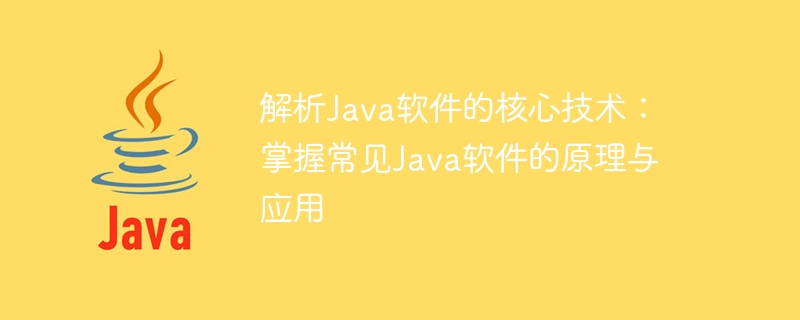Home >Java >javaTutorial >Explore the principles and applications of common Java software: In-depth understanding of the core technology of Java software
Explore the principles and applications of common Java software: In-depth understanding of the core technology of Java software
- WBOYWBOYWBOYWBOYWBOYWBOYWBOYWBOYWBOYWBOYWBOYWBOYWBOriginal
- 2024-01-24 10:51:061015browse

Analysis of the core technology of Java software: Mastering the principles and applications of common Java software requires specific code examples
Java is an advanced subject that is widely used in the field of software development. The programming language, with its powerful cross-platform features and rich class library functions, has become the first choice of many software engineers. To master the core technology of Java software, you not only need to understand its basic principles, but also need to understand its application through specific code examples. This article will analyze some common Java software to help readers better understand and apply these software.
1. Tomcat
Tomcat is an open source Java Servlet container used to implement Java Web applications. Its main function is to provide a Web container environment in accordance with the Java Servlet and JavaServer Pages (JSP) specifications. Next, we use a simple example to illustrate the use of Tomcat.
Sample code:
import javax.servlet.*;
import javax.servlet.http.*;
import java.io.*;
public class HelloWorld extends HttpServlet {
public void doGet(HttpServletRequest request, HttpServletResponse response)
throws ServletException, IOException {
response.setContentType("text/html");
PrintWriter out = response.getWriter();
out.println("<html>");
out.println("<head><title>Hello World</title></head>");
out.println("<body>");
out.println("<h1>Hello World!</h1>");
out.println("</body>");
out.println("</html>");
}
}In the above code, we define a class named HelloWorld, which inherits from the HttpServlet class. By overriding the doGet method, we specify how the servlet responds when it receives a GET request. In this example, we simply output a Hello World web page.
2. Spring Framework
Spring is a lightweight Java development framework designed to simplify Java application development. Its core principles are dependency injection and aspect-oriented programming.
Sample code:
import org.springframework.context.ApplicationContext;
import org.springframework.context.support.ClassPathXmlApplicationContext;
public class HelloSpring {
public static void main(String[] args) {
ApplicationContext context = new ClassPathXmlApplicationContext("beans.xml");
HelloWorld helloWorld = (HelloWorld) context.getBean("helloWorld");
helloWorld.printMessage();
}
}
public class HelloWorld {
private String message;
public void setMessage(String message) {
this.message = message;
}
public void printMessage() {
System.out.println("Message: " + message);
}
}In the above code, we use Spring's IoC (Inversion of Control) function to define a bean named helloWorld through the configuration file beans.xml. In the code, we obtain the bean through the ApplicationContext object and call its printMessage method.
Through the above examples, we can see that the dependency injection and control inversion features of the Spring framework allow us to manage the creation and management of objects through configuration files.
3. Hibernate
Hibernate is an open source object-relational mapping framework used to map Java objects to relational databases. It provides an object-oriented query language (HQL) that eliminates the hard coding of SQL statements and provides flexible data access methods.
Sample code:
import javax.persistence.*;
@Entity
@Table(name = "students")
public class Student {
@Id
@GeneratedValue(strategy = GenerationType.IDENTITY)
private int id;
private String name;
private int age;
// Getters and setters
}
public class HibernateExample {
public static void main(String[] args) {
EntityManagerFactory emf = Persistence.createEntityManagerFactory("persistenceUnit");
EntityManager em = emf.createEntityManager();
EntityTransaction tx = em.getTransaction();
tx.begin();
Student student = new Student();
student.setName("Tom");
student.setAge(20);
em.persist(student);
tx.commit();
em.close();
emf.close();
}
}In the above code, we define an entity class named Student, and use Hibernate annotations to indicate the table name and attributes to be mapped to the database. Column correspondence. In the HibernateExample class, we create an EntityManager object through EntityManagerFactory, instantiate the Student object, and persist it to the database by calling the em.persist method.
Summary:
Through the above analysis of the code examples of Tomcat, Spring and Hibernate, we can have a deeper understanding of the core technology of Java software, including the development of Web applications (Tomcat), The use of lightweight IoC framework (Spring Framework), and the operation of ORM framework (Hibernate). Through actual code examples, we can better understand the principles and application methods of these technologies, so as to better develop and design Java software. I believe that through learning and practice, readers can become more proficient in mastering these common Java software and improve their development capabilities.
The above is the detailed content of Explore the principles and applications of common Java software: In-depth understanding of the core technology of Java software. For more information, please follow other related articles on the PHP Chinese website!

